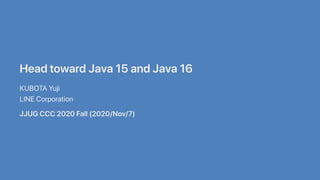Head toward Java 15 and Java 16
- 6. Additionalincompabilitiyexample No. #now() returnsnanosecondspartbyJDK-8068730(Java9) # Version 14.0.2 jshell> var now = java.time.LocalDateTime.now() now ==> 2020-10-08T16:19:01.738366 # Version 15 jshell> var now = java.time.LocalDateTime.now() now ==> 2020-10-08T16:19:08.485590579 jshell> var now = java.time.LocalDateTime.now() ...> .truncatedTo(java.time.temporal.ChronoUnit.MICROS) now ==> 2020-10-08T16:19:12.943847 6
- 7. Additionalincompabilitiyexample(Cont.) #now() returnsnanosecondspartbyJDK-8068730(Java9) # Version 15, Linux jshell> var now = java.time.LocalDateTime.now() now ==> 2020-10-08T16:30:29.534948147 jshell> System.getProperty("os.name") $2 ==> "Linux" # Version 15, macOS jshell> var now = java.time.LocalDateTime.now() now ==> 2020-10-08T16:31:26.815258 jshell> System.getProperty("os.name") $2 ==> "Mac OS X" WindowsżŽżŌż├ż╚Ū░(ŁhŠ│ż¼ż╩żżż╬żŪ╬┤┤_šJ) 7
- 8. Glossary:?šZ╝»(2/2) Incubator(JEP11) JavaAPIż╬įć“Y?źŌźĖźÕ®`źļ( jdk.incubator ) ś╦£╩╗»ż╦Ž“ż▒żŲźšźŻ®`ź╔źąź├ź»ż“Ą├żŲēõĖ³żĘżõż╣żżżĶż”ż╦╠žäeż╩źŌźĖźÕ®`źļż╦żĘżŲżżżļĪŻėą ä┐ż╦ż╣żļż╦żŽ --add-modules jdk.incubator.xxx ż╬ųĖČ©ż¼▒žę¬ Preview(JEP12) Java?šZżõJVMż╬įć“YÖC─▄ĪŻėąä┐ż╦ż╣żļż╦żŽ --enable-preview ż╬ųĖČ©ż¼▒žę¬ĪŻź│ź¾źčźż źļĢrż╦żŽ --resource ż½ -source ż╬ųĖČ©żŌ▒žę¬ Standard ╔Žėøż╬źŲź╣ź╚źšź¦®`ź║ż“═©żĖżŲś╦£╩ÖC─▄ż╦ĢNĖ±żĘż┐ÖC─▄ĪŻĮ±ż╬ż╚ż│żĒżŽ2╗ž(└²:Preview-> SecondPreview->Standard)żŪĢNĖ±żĘżŲżżżļ 8
- 11. 15:375:PatternMatchingforinstanceof(SecondPreview) ▒│Š░: instanceof żŪą═?▌^żĘżŲ?├„żŪżŌźŁźŃź╣źŲźŻź¾ź░Ą╚ż¼▒žę¬ └¹ĄŃ:ź│®`ź╔ż╬┐╔ęĢąį?źßź¾źŲź╩ź¾ź╣ąįż¼Ž“╔Ž Ū░╗ž(JEP305)ż½żķēõĖ³ż╩żĘżŪSecondPreviewżž // Before if (obj instanceof Double) { double d = ((Double) obj).doubleValue(); // uses d here. } // After if (obj instanceof Double d) { // uses d here. // bindingżĘżŲżļéÄż╦┤·?żŽź└źßĪóź│ź¾źčźżźļź©źķ®`ż¼░k?ż╣żļ d = 2.0; } else { // can't use d here. } 11
- 12. (Drafting)thesamewayon switch äeJEPżŪswitch?żŪżŌ└¹?żŪżŁżļżĶż”ż╦ż╩żļėĶČ©żŪż╣ĪŻż┐ż└żĘĢrŲ┌╬┤įö switch (obj) { case Integer i: // uses i here. case Double d: // uses d here. } public double area(Shape shape) { return switch(shape) { case Circle c -> Math.PI * c.radius() * c.radius(); case Rectangle r -> r.length() * r.width(); case Square s -> s.length() * s.width(); default -> 0; } } 12
- 13. 15:378:TextBlocks ▒│Š░:Javaż╦żŌźęźóź╔źŁźÕźßź¾ź╚▒ĒėøÖC─▄ż“ŻĪ └¹ĄŃ: String ż╦źęźóź╔źŁźÕźßź¾ź╚ÖC─▄ż¼ūĘ╝ėżĄżņż┐ Ū░╗ž(JEP-368)ż½żķēõĖ³ż╩żĘżŪś╦£╩ÖC─▄ż╦ĢNĖ± jshell> var textblock = """ ...> Duke is ...> cute s ...> """; textblock ==> "Duke is cute n" 13
- 15. 15:384:Records(SecondPreview)(Cont.) //?Ę¼źĘź¾źūźļż╩Ģ°żŁ? public record TestRecord(String s, int i) {} public final class TestRecord(String s, int i) extends java.lang.Record { private final String s; private final int i; String s() { return s; } int i() {return i;} TestRecord(String s, int i) { this.s = s; this.i = i; } // toString(), equals(), hashCode() } 15
- 16. 15:384:Records(SecondPreview)(Cont.) public final class TestRecord(String s, int i) extends java.lang.Record { Immutable recordżŽ│Żż╦ final ź»źķź╣ (java.lang.Recordż“ÆłÅłżĘżŲżżżļż╬żŪ)recordżŽźżź¾ź┐®`źšź¦®`ź╣ż“īgū░żŪżŁżļż¼ź»źķ ź╣ż“ÆłÅłżŽżŪżŁż╩żż (═¼żĖ└Ēė╔żŪ)Objectź»źķź╣ż¼│ųż─ęįŽ┬ż╬3ż─ż╬źßźĮź├ź╔ż¼░Ą³aĄ─ż╦īgū░żĄżņżŲżżżļ // toString(), equals(), hashCode() equals() żŽrecordż¼│ųż─źšźŻ®`źļź╔ż¼═¼éÄżŪżóżņżą│Żż╦ true 16
- 17. 15:384:Records(SecondPreview)(Cont.) private final String s; private final int i; Immutable źšźŻ®`źļź╔żŽ private final żŪsetterżŌż╩żĘ Reflectionż“╩╣ż├żŲżŌēõĖ³żŽ▓╗┐╔ żõż├ż┐żķ IllegalAccessException ż¼═Čż▓żķżņżļ String s() { return s; } int i() {return i;} FluentgetterAPI, getS żõ getI ż╬żĶż”ż╦ getXX żŽūĘ╝ėżŪżŁż╩żż 17
- 18. 15:384:Records(SecondPreview)(Cont.) // ?░ŃĄ─ż╩?│╔żĄżņż┐ź│ź¾ź╣ź╚źķź»ź┐ TestRecord(String s, int i) { this.s = s; this.i = i; } Ž┬ėøż╬żĶż”ż╦ź│ź¾ź╣ź╚źķź»ź┐żŪŚ╩į^(validate)żõéÄż╬?│╔żŌ┐╔─▄ public record TestRecord(String s, int i) { public TestRecord() { this("Default S", 1000); } public TestRecord(String s, int i) { if (s.isEmpty()) { throw new IllegalArgumentException(); } this.s = s; this.i = i; } } 18
- 19. 15:360:SealedClasses(Preview) ▒│Š░:īgū░?Š@│ąŽ╚ż“═¼?ź│ź¾źčźżźļģg╬╗ż╦Ž▐Č©żĘż┐żż └¹ĄŃ:īgū░ż“?ż”ź│®`ź╔żõ(Į½└┤Ą─ż╦)źčź┐®`ź¾ź▐ź├ź┴ż╬╣Āćņż“ųĖČ©żŪżŁżļ // classż╬Ū░ż╦ sealed ż“ą¹? public sealed class Shape // permits ż╬ßßż╦īgū░?Š@│ąŽ╚ż“ėø╩÷ż╣żļ permits com.example.polar.Circle, com.example.quad.Rectangle, com.example.quad.simple.Square {...} // interfaceżŌ═¼śö public sealed interface Shape permits Circle, Rectangle, Square {...} 19
- 20. 15:360:SealedClasses(Preview)(Cont.) permits żŪųĖČ©żĘż┐źĄźųź»źķź╣ż╦ż¬ż▒żļųŲ╝s sealedź»źķź╣/źżź¾ź┐®`źšź¦®`ź╣ż╚═¼?źŌźĖźÕ®`źļ─┌ unnamedmoduleż╬ł÷║ŽżŽ═¼?źčź├ź▒®`źĖ─┌ ų▒Įėsealedź»źķź╣/źżź¾ź┐®`źšź¦®`ź╣ż“ÆłÅłż╣żļ▒žę¬ż¼żóżļ ęįŽ┬ż╬3ż─ż╬constraintsż╬ż”ż┴?ż─ż“├„ėøż╣żļ▒žę¬ż¼żóżļ final :ż│żņęį╔Žż╬ÆłÅłż“Į¹? sealed : permits żŪųĖČ©żĘż┐źĄźųź»źķź╣ż╬ż▀įS┐╔ non-sealed :ųŲ╝sż╩żĘ public final class Rectangle extends Shape {...} public sealed class Rectangle extends Shape permits Cube {...} public non-sealed class Square extends Shape {...} 20
- 21. 15:360:SealedClasses(Preview)(Cont.) źčź┐®`ź¾ź▐ź├ź┴(ą═źŲź╣ź╚źčź┐®`ź¾)ż╬╣Āćņż“ųĖČ©żŪżŁżļ...ż╚żŽŻ┐ sealedź»źķź╣ż“ę²Š@ż░źĄźųź»źķź╣ż¼ųĖČ©żĄżņżŲżżżļ ź│ź¾źčźżźķ(javac)ż¼ŠW┴_Ą─ż╩╣Āćņż¼ż’ż½żļ default ż¼▓╗ꬿ╦ż╩żļ ŠW┴_żĄżņżŲż╩ż▒żņżąź│ź¾źčźżźļĢrż╦ėø▌dż“═ŲŖXżĄżņżļ // p.12 żĶżĻį┘Æ„ public double area(Shape shape) { return switch(shape) { case Circle c -> Math.PI * c.radius() * c.radius(); case Rectangle r -> r.length() * r.width(); case Square s - s.length() * s.width(); } } Recordż╚ĮMż▀║Žż’ż╗żļż│ż╚żŌ┐╔─▄ RecordżŽ│Żż╦ final ż╩ż╬żŪconstraintsż“Ü▌ż╦ż╣żļ▒žę¬żŌż╩żż 21
- 23. 15:371:HiddenClasses(Cont.) ╚½ź»źķź╣żŽ═¼żĖź»źķź╣źĒ®`ź└®`ļAīėż╦żżżļäeź»źķź╣ż½żķ├¹Ū░ĮŌøQżĘżŲ źĻź¾ź»ż╣żļż│ż╚ż¼┐╔─▄ Class::forName , Classloader::loadClass Hiddenclassż“ū„żļż┐żßż╬APIż¼MethodHandles.Lookupż╦ūĘ╝ėżĄżņż┐ MethodHandles.Lookup#defineHiddenClass(byte[] bytes, boolean initialize, MethodHandles.Lookup.ClassOption... options) byte[] ż╦ź»źķź╣Ūķł¾ż“Ė±╝{żĘżŲż’ż┐żĘĪóreflectiveaccessż“╠ß╣®ż╣żļ Lookup ź¬ źųźĖź¦ź»ź╚ż“½@Ą├ż╣żļ ż│ż╬ Lookup ź¬źųźĖź¦ź»ź╚ż¼╬©?ż╬źóź»ź╗ź╣?Č╬ MethodHandles.LookupżŽJava7ż½żķżóżļż╬żŪŠ▀╠ÕĄ─ż╩╩╣żż?żŽAPIDocż“▓╬šš 23
- 24. 15:371:HiddenClasses(Cont.) $ cat Hidden.java public class Hidden { public void hello() { System.out.println(hello); } } $ cat HiddenCaller.java import java.lang.invoke.MethodHandles; import java.nio.file.*; public class HiddenCaller { // ║åęū╗»ż╬ż┐żßż╦└²═ŌäI└ĒżŽ═Čż▓Æ╬żŲżŲż▐ż╣(Don't do that) public static void main(String... args) throws Exception { MethodHandles.Lookup lookup = MethodHandles.lookup(); // źĒ®`ź½źļźšźĪźżźļźĘź╣źŲźÓ╔Žż╦żóżļź»źķź╣źšźĪźżźļż½żķbyte[]żžĖ±╝{ byte[] bytes = Files.readAllBytes(Paths.get(Hidden.class)); // ą┬żĘż»ūĘ╝ėżĄżņż┐APIżŪHidden classż“Č©┴x lookup.defineHiddenClass(bytes, false); Class? clazz = lookup.findClass(Hidden); // ÅŠ└┤ż╚═¼śöż╬?ĒśżŪ hello źßźĮź├ź╔ż“░k? Object instance = clazz.getDeclaredConstructor().newInstance(); clazz.getDeclaredMethod(hello).invoke(instance); } } $ java HiddenCaller hello ref.https://blogs.oracle.com/javamagazine/the-unsafe-class-unsafe-at-any-speed 24
- 25. 15:383:Foreign-MemoryAccessAPI(SecondIncubator) ▒│Š░:ź╗źŁźÕźóżŪä┐┬╩Ą─ż╩źę®`źū═ŌźßźŌźĻż╦źóź»ź╗ź╣ż╣żļś╦£╩APIż¼ż╩żż └¹ĄŃ:╝╚┤µ?Č╬żĶżĻä┐┬╩Ą─ż½ż─źßź¾źŲź╩ź¾ź╣żĄżņżļś╦£╩APIż¼╠ß╣®żĄżņżļ ╝╚┤µ?Č╬ż╬źŪźßźĻź├ź╚ allocateDirect ( ByteBuffer ) ź¬źųźĖź¦ź»ź╚ż┤ż╚ż╦╔ŽŽ▐2G( Integer.MAX_VALUE ) źßźŌźĻĮŌĘ┼ź┐źżź▀ź¾ź░ż¼GCę└┤µ JavaNativeInterface(JNI) źßźŌźĻ╣▄└Ēż“?ĘųżŪżõżļż╬ż¼?ķg ź═źżźŲźŻźųż╚Javaķgż╬źŁźŃź╣źŲźŻź¾ź░ż¼ź¬®`źąźžź├ź╔ Unsafe.allocateMemory() ├¹Ū░ż╬═©żĻJVMź»źķź├źĘźÕż“ę²żŁŲż│ż╣ż╩ż╔Unsafe ?╣½╩ĮAPIż╩ż╬żŪĮ½└┤Ą─ż╦¤oŠ»ĖµżŪŽ„│²ż╬┐ųżņż¼żóżļ ėąä┐ż╦ż╣żļż╦żŽ --add-modules jdk.incubator.foreign ż¼Īó▒žę¬ 25
- 27. 15:383:Foreign-MemoryAccessAPI(SecondIncubator)(Cont.) Į±╗žūĘ╝ėżĄżņż┐MemoryHandlesż“?żżżŲJava9ż½żķī¦?żĄżņżŲżżżļ VarHandleż“ĮķżĘżŲźßźŌźĻź╗ź░źßź¾ź╚ż╦źóź»ź╗ź╣ż╣żļ // VarHandleż“ĮķżĘżŲ int ą═ż“£╩éõ VarHandle intHandle = MemoryHandles.varHandle(int.class, ByteOrder.nativeOrder()); // 100 bytesźßźŌźĻź╗ź░źßź¾ź╚ż“źóźĒź▒®`ź╚żĘżŲźóź»ź╗ź╣ try (MemorySegment segment = MemorySegment.allocateNative(100)) { MemoryAddress base = segment.baseAddress(); for (int i = 0; i 25; i++) { // Foreign-Memory Access. intHandle.set(base.addOffset(i * 4), i); } } ref.http://cr.openjdk.java.net/~mcimadamore/panama/foreign-memaccess.html 27
- 31. 16:338:VectorAPI(Incubator)(Cont.) Ī∙:SIMD:SingleInstruction,MultipleData.č}╩²ż╬źŪ®`ź┐ż╦īØżĘżŲ═¼żĖ▓┘ū„ż“═¼Ģrż╦īg?ż╣żļ ż│ż╚ż“┐╔─▄ż╦ż╣żļĪó1ż─ż╬CPUźĄźżź»źļżŪżĶżĻČÓż»ż╬ū„śIż“īg?żŪżŁżļżĶż”ż╦ż╣żļż│ż╚żŪüK┴ą Č╚║Žżżż¼Ž“╔Žż╣żļ╩╦ĮMż▀ └¹?ż╣żļż╦żŽ --add-module jdk.incubator.vector ż¼▒žę¬ ╣½╩Įż╬ź▐źżź»źĒź┘ź¾ź┴ź▐®`ź»źŲź╣ź╚ź│®`ź╔:https://github.com/openjdk/panama- vector/tree/vectorIntrinsics/test/jdk/jdk/incubator/vector/benchmark ref.https://bugs.openjdk.java.net/browse/JDK-8244490 31














![15:384:Records(SecondPreview)
▒│Š░:lombokż╬@Valueż╬żĶż”ż╦░▓╚½ż╩źŪ®`ź┐ź»źķź╣ż“ū„żļż┐żßż╦┐╝æ]?īgū░żĘż╩ż▒żņżążżż▒
ż╩żż╣Āćņż¼ČÓż╣ż«żļ
└¹ĄŃ:ś╦£╩APIżŪ░▓╚½(żŪźĘź¾źūźļ)ż╩źŪ®`ź┐źŌźŪźļż“ū„żņżļ
Ū░╗žż½żķźĒ®`ź½źļź»źķź╣?źżź¾ź┐®`źšź¦®`ź╣żžż╬ūĘ╝ėīØÅĻż¼?ż’żņż┐
14](https://image.slidesharecdn.com/jug2-201129035931/85/Head-toward-Java-15-and-Java-16-14-320.jpg)








![15:371:HiddenClasses(Cont.)
╚½ź»źķź╣żŽ═¼żĖź»źķź╣źĒ®`ź└®`ļAīėż╦żżżļäeź»źķź╣ż½żķ├¹Ū░ĮŌøQżĘżŲ
źĻź¾ź»ż╣żļż│ż╚ż¼┐╔─▄
Class::forName , Classloader::loadClass
Hiddenclassż“ū„żļż┐żßż╬APIż¼MethodHandles.Lookupż╦ūĘ╝ėżĄżņż┐
MethodHandles.Lookup#defineHiddenClass(byte[] bytes, boolean
initialize, MethodHandles.Lookup.ClassOption... options)
byte[] ż╦ź»źķź╣Ūķł¾ż“Ė±╝{żĘżŲż’ż┐żĘĪóreflectiveaccessż“╠ß╣®ż╣żļ Lookup ź¬
źųźĖź¦ź»ź╚ż“½@Ą├ż╣żļ
ż│ż╬ Lookup ź¬źųźĖź¦ź»ź╚ż¼╬©?ż╬źóź»ź╗ź╣?Č╬
MethodHandles.LookupżŽJava7ż½żķżóżļż╬żŪŠ▀╠ÕĄ─ż╩╩╣żż?żŽAPIDocż“▓╬šš
23](https://image.slidesharecdn.com/jug2-201129035931/85/Head-toward-Java-15-and-Java-16-23-320.jpg)
![15:371:HiddenClasses(Cont.)
$ cat Hidden.java
public class Hidden {
public void hello() {
System.out.println(hello);
}
}
$ cat HiddenCaller.java
import java.lang.invoke.MethodHandles;
import java.nio.file.*;
public class HiddenCaller {
// ║åęū╗»ż╬ż┐żßż╦└²═ŌäI└ĒżŽ═Čż▓Æ╬żŲżŲż▐ż╣(Don't do that)
public static void main(String... args) throws Exception {
MethodHandles.Lookup lookup = MethodHandles.lookup();
// źĒ®`ź½źļźšźĪźżźļźĘź╣źŲźÓ╔Žż╦żóżļź»źķź╣źšźĪźżźļż½żķbyte[]żžĖ±╝{
byte[] bytes = Files.readAllBytes(Paths.get(Hidden.class));
// ą┬żĘż»ūĘ╝ėżĄżņż┐APIżŪHidden classż“Č©┴x
lookup.defineHiddenClass(bytes, false);
Class? clazz = lookup.findClass(Hidden);
// ÅŠ└┤ż╚═¼śöż╬?ĒśżŪ hello źßźĮź├ź╔ż“░k?
Object instance = clazz.getDeclaredConstructor().newInstance();
clazz.getDeclaredMethod(hello).invoke(instance);
}
}
$ java HiddenCaller
hello
ref.https://blogs.oracle.com/javamagazine/the-unsafe-class-unsafe-at-any-speed 24](https://image.slidesharecdn.com/jug2-201129035931/85/Head-toward-Java-15-and-Java-16-24-320.jpg)

![15:383:Foreign-MemoryAccessAPI(SecondIncubator)(Cont.)
Keyconcepts
Thread:Segmentż“ū„│╔żĘżŲ╦∙ėąż╣żļź╣źņź├ź╔
Segment:źßźŌźĻź╗ź░źßź¾ź╚ĪŻJavaźę®`źūżóżļżżżŽJavaźę®`źū═Ōż╦żóżļźßźŌźĻŅIė“ż“źŌ
źŪźļ╗»żĘż┐Ė┼─ŅĪŻ╦∙ėążĘżŲżżżļź╣źņź├ź╔ż╬ż▀ż¼źóź»ź╗ź╣żŪżŁżļ(╦∙ėąśžżŽęŲūj┐╔─▄)
Slice:ęįŽ┬ż╬Š│Įń(bounds)ż“╣▓ėąż╣żļSegmentż╬?▓┐ŅIė“
┐šķgĄ─Š│Įń:SliceżŽSegmentż╬┐šķg╣Āćņ─┌ż╦┤µį┌ż╣żļ
ĢrķgĄ─Š│Įń:Segmentż╚SliceżŽ═¼Ģrż╦ź»źĒ®`ź║żĄżņżļ
Segmentż¼ķ]żĖżķżņżļż╚SliceżŌķ]żĖżķżņżļĪŻ─µżŌ═¼śö
26](https://image.slidesharecdn.com/jug2-201129035931/85/Head-toward-Java-15-and-Java-16-26-320.jpg)








































































![Secrets of Rock Star Developers (and How to Become One!) [CON7615] (Yuji KUBO...](https://cdn.slidesharecdn.com/ss_thumbnails/bruno-171002204755-thumbnail.jpg?width=560&fit=bounds)

















